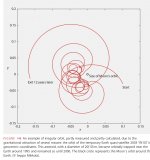My father took me to the Imperial War Museum in London when I was 12 years of age - some years before my independent visits to London.
As an aircraft engineer fitter in the RAF during WW2, this was obviously his first port of call!
IWM Collections | Imperial War Museums
As an aircraft engineer fitter in the RAF during WW2, this was obviously his first port of call!
IWM Collections | Imperial War Museums
Sutton Hoo about 50 miles from where I am now. Hopefully later this summer if things go well we will make it down there.
+
The British Museum - Sutton Hoo
V&A - jewellery collection
Ah I forgot. We did the V&A as well (right next to the NHM). There was an eight hundred year old Persian carpet in there measuring about 80 x 30 foot at the time.
I friend of mine is a carpet fitter.There was an eight hundred year old Persian carpet in there measuring about 80 x 30 foot at the time.
Walter Wall.
We don't know why gravity exists, we can only manufacture theories to help explain how it works.Do we actually know yet, why gravity exists? Sorry, haven't read the entire thread.
Gravity was discussed fairly recently in fact, if you care to scroll back a little.
yes I'll scroll back, thank you. Gravity always seemed to be the one elusive reason that man had yet to concur.
Yes, it's a continuing puzzle why the most familiar force in our everyday lives, gravity, is not part of the Standard Model.
What's amazing to me, is how scientists could predict the gravity of other celestial bodies, navigating their things (push/pull, or pull/push). That an object could meet one time/space and be catapulted further, into another continuum. It's incredible.
Last edited:
Here is a graphic from MM showing the path of a satellite (a lump of rock) captured by the Earth as it rotated around the sun. The satellite remained tethered to the Earth for about 12-yrs before wandering off again, probably due to the gravitational disturbance of the sun and other planets.
Attachments
Let me fix this for you:
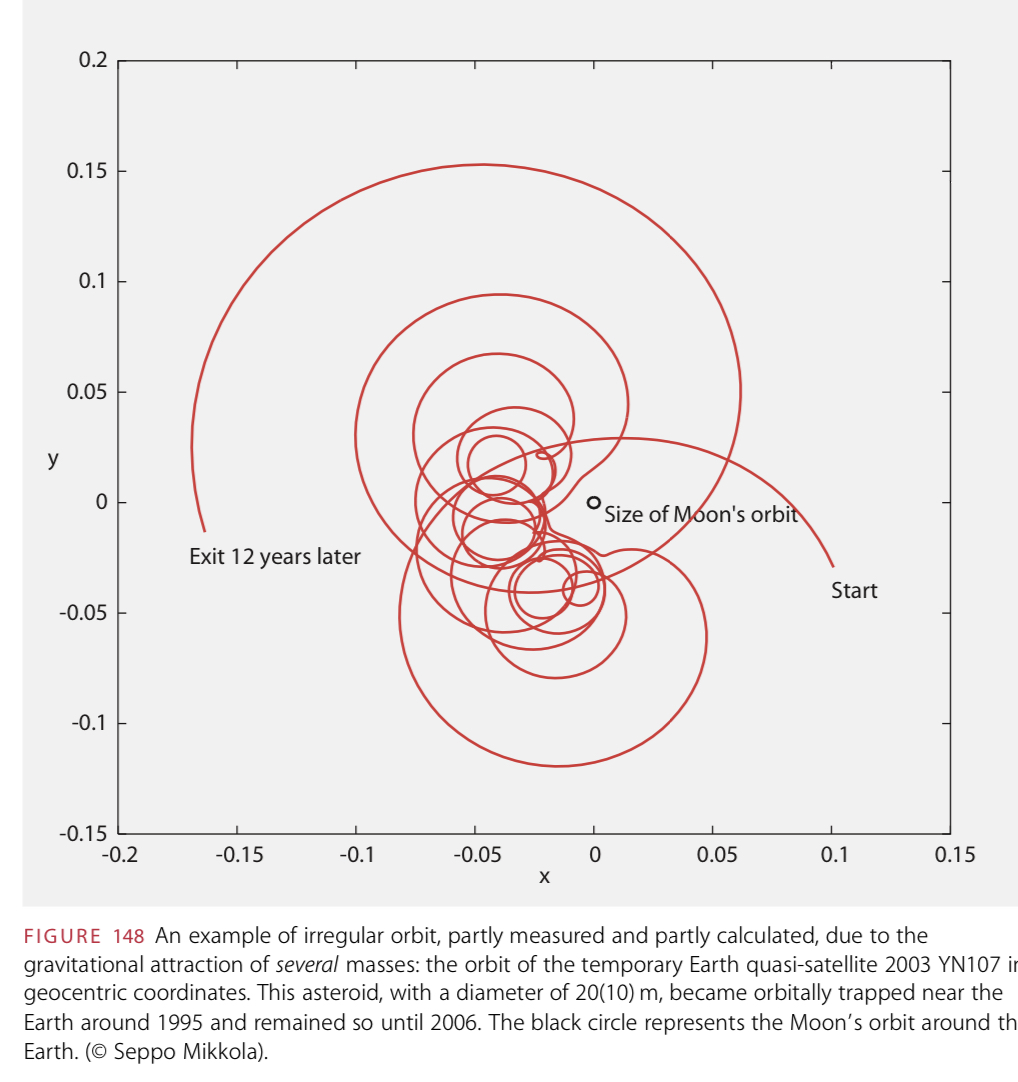
Motion Mountain - The Captivating Free Physics Pdf Book
Just my opinion, Bonsai, but a sloppy piece of work. Always give the references. 😀
Motion Mountain - The Captivating Free Physics Pdf Book
Motion Mountain p192 Vol 1 said:Figure 148 An example of irregular orbit, partly measured and partly calculated, due to the
gravitational attraction of several masses: the orbit of the temporary Earth quasi-satellite 2003 YN107 in
geocentric coordinates. This asteroid, with a diameter of 20(10) m, became orbitally trapped near the
Earth around 1995 and remained so until 2006. The black circle represents the Moon’s orbit around the
Earth. (© Seppo Mikkola).
Just my opinion, Bonsai, but a sloppy piece of work. Always give the references. 😀
I referenced it as ‘MM’ but you are right, I should have fully referenced it. Thank you!
(My OU uni prof would be wagging his finger at me . . . Instead, Steve is here to provide the requisite slap to the back of the head 😀)
(My OU uni prof would be wagging his finger at me . . . Instead, Steve is here to provide the requisite slap to the back of the head 😀)
There's a lot of "wandering" going on in the Solar System!...before wandering off again...
Let's not forget that the word planet is from the Greek word plan

This short film entitled "Wanderers", written and narrated by Carl Sagan, is worth taking a look at for its amazing images:
Wanderers - a short film by Erik Wernquist [Official Version] - YouTube
That was rather good, Galu! But gave me terrible vertigo... 😀
I hate heights and precipices! 😱
Getting back to Bonsai's surprising bit of orbital mechanics, I read an amazing book about the surprising subtleties of gravity and the solar system:
Calculating the Cosmos: How Mathematics Unveils the Universe: Amazon.co.uk: Stewart, Professor Ian: 9781781254318: Books
We had this fascinating Jupiter/Saturn conjunction at Christmas:
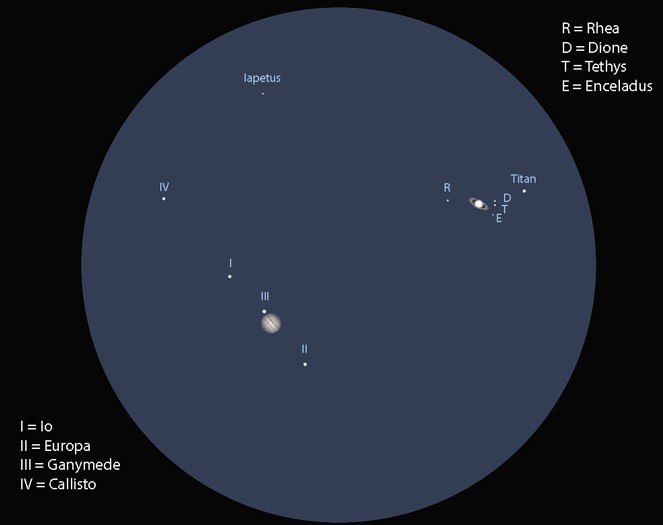
I have always been amazed by Jupiter's moons in 1:2:4 orbital resonance:
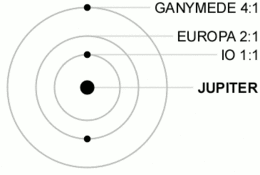
Callisto and Ganymede have an approx 22:7 ratio of orbital times. Don't know if Callisto is holding this thing together, Or Io's highly elliptical orbit.
You never see all three in a line. But this is not a permanent state of affairs. BTW, Wiki has got the animation wrong. Strictly speaking the 1:2:4 resonance is reference the perihelion of IO. It precesses. It is estimated that Mercury could end up anywhere over the next few Billion years. It could even be ejected from the solar system altogether. The rings of Saturn are also only a current phenomenen. Might last only another Million years before becoming unstable.
I hate heights and precipices! 😱
Getting back to Bonsai's surprising bit of orbital mechanics, I read an amazing book about the surprising subtleties of gravity and the solar system:
Calculating the Cosmos: How Mathematics Unveils the Universe: Amazon.co.uk: Stewart, Professor Ian: 9781781254318: Books
We had this fascinating Jupiter/Saturn conjunction at Christmas:
I have always been amazed by Jupiter's moons in 1:2:4 orbital resonance:
Callisto and Ganymede have an approx 22:7 ratio of orbital times. Don't know if Callisto is holding this thing together, Or Io's highly elliptical orbit.
You never see all three in a line. But this is not a permanent state of affairs. BTW, Wiki has got the animation wrong. Strictly speaking the 1:2:4 resonance is reference the perihelion of IO. It precesses. It is estimated that Mercury could end up anywhere over the next few Billion years. It could even be ejected from the solar system altogether. The rings of Saturn are also only a current phenomenen. Might last only another Million years before becoming unstable.
Last edited:
I read that the rings of Saturn are not older than 100 million yrs and will eventually dissipate but I think in the bit I read it was another 100 million. But whatever, it is a transitory phenomena.
And, of course, orbital resonances also apply to entire galaxies!I have always been amazed by Jupiter's moons in 1:2:4 orbital resonance.
Modelling resonances and orbital chaos in disk galaxies - Application to a Milky Way spiral model | Astronomy & Astrophysics (A&A)"Resonances in the stellar orbital motion under perturbations from the spiral arm structure can play an important role in the evolution of the disks of spiral galaxies."
One of the main questions which divides the astronomical community is the lifetime of the spiral structure. Some studies suggest that that spiral arms are transient, appearing and disappearing in a recurrent way.
This article looks at the formation of 'bars' in spiral galaxies and analyses their lives and deaths: Secular Evolution in Disk Galaxies - John Kormendy

It's all putting my head in a spin!

I saw one around age 12 (circa 1970) at one of the Smithsonian museums in Washington DC. There was lots of good stuff there. It's been on my bucket list to go back.I forget where I saw one of these things, maybe the Science Museum. I seem to remember a crowd would gather at midday to see the curator start it up.
Foucault's Pendulum:
Another thing I remember seeing there was the computer memory CRTs they used before developing core memory. In recent years I read some computer history book about it (the cost spurred on the development of the more reliable and cheaper core memory that replaced it). The tubes were expensive, they had a limited life and so had to be replaced fairly often. The cost of memory using these tubes was about one dollar per bit per month.
Foucault's pendulum is an interesting experiment. Sufficiently good engineers could have built one 5,000 years ago. I wonder if they did? 😕
Foucault pendulum - Wikipedia
My investigations have revealed that 30 degrees is the crucial angle:
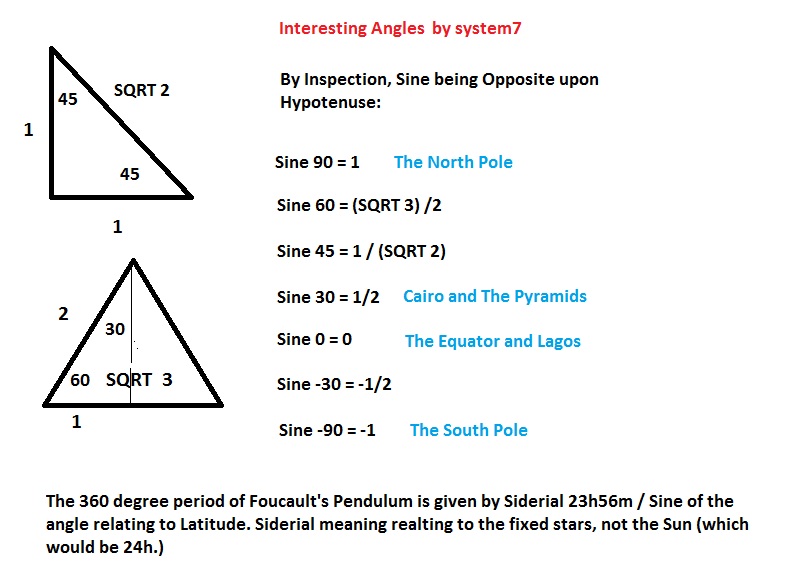
But what I most noticed is that the Great Pyramid was built on a latitude of 30N. Coincidence? I think not. 😎
Pyramid Calculator
Great Pyramid of Giza - Wikipedia
The height was 280 Royal Cubits. The length of the 4 bases 440 Royal Cubits. A Cubit being about half a metre.
Perimeter length over height = 1760 / 280 = 6.2857...
That is 2 Pi, my friends. Mystery of Pyramids solved. 😀
Foucault pendulum - Wikipedia
My investigations have revealed that 30 degrees is the crucial angle:
But what I most noticed is that the Great Pyramid was built on a latitude of 30N. Coincidence? I think not. 😎
Pyramid Calculator
Great Pyramid of Giza - Wikipedia
The height was 280 Royal Cubits. The length of the 4 bases 440 Royal Cubits. A Cubit being about half a metre.
Perimeter length over height = 1760 / 280 = 6.2857...
That is 2 Pi, my friends. Mystery of Pyramids solved. 😀
In other news
Cern experiment hints at new force of nature | Large Hadron Collider | The Guardian
(Source: Front page of the Guardian, 23rd March 2021 at 11:39 local time 😀 )
Cern experiment hints at new force of nature | Large Hadron Collider | The Guardian
(Source: Front page of the Guardian, 23rd March 2021 at 11:39 local time 😀 )
- Status
- Not open for further replies.
- Home
- Member Areas
- The Lounge
- What is the Universe expanding into..
